Take Home
Message
Introduction
Cow Comfort
If a cow limits her DM intake because of uncomfortable free-stalls the following consequences may occur:
These problems are very costly and are frequently blamed on the nutrition program. But in reality they can be due to cows standing for too many hours of the day.
Evaluating Cow Comfort
Cows must make several decisions prior to lying down, the decisions that we speculate the cows must make will give us an opportunity to evaluate where potential problems arise. Is it easy for the cow to step up into the free-stall? An 8 inch curb is probably ideal. However, cows have been observed to step up 14 inches to enter comfortable free-stalls. Take the time to observe several cows in the process of lying down. Do they bang into anything? Are they hesitant or confident? Are any physical injuries occurring as they lie down? Stand in a typical free-stall and free fall to your knees. Is it a painful experience? Now watch cows in the process of standing. Do they do it with ease? Is there adequate lunge space? Do they bang into anything? Take a good look at the physical condition of your cows. If your cows have swollen knees, or swollen or abraded hocks then you have a free-stall problem. What about the rump and hooks area? Are there abscesses, or bumps and bruises? Upon completion of these simple tests you should have an idea whether or not your free-stalls require modification.
![]() Free-stalls
Free-stalls
Free-stall design must consider lying/standing space along with moving or dynamic space requirements of the cow (6). The two most important design criteria are bed surface and stall length. If designed correctly, cows will readily access their stalls.
If forward or sideways lunging space is inadequate, the ability to stand will become restricted. Psychological space must be included between the wall and the forward position during lunging. Also, if the dimensions of the free-stall are correct the position of the cow can be controlled. Figure 1 shows the free-stall components and suggested dimensions (6).
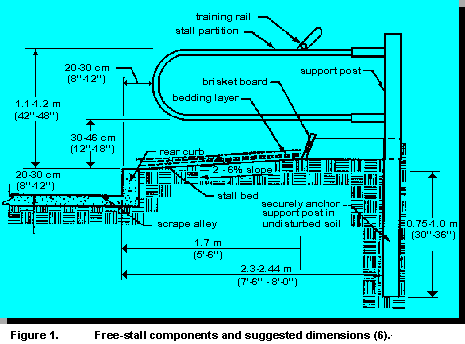
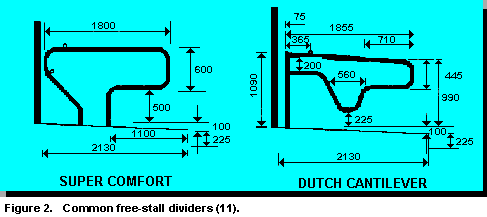
![]() Stall Bed Alternatives
Stall Bed Alternatives
The flooring material used for rest areas is very important for cow comfort. House et al. (10) cited research that free-stall surfaces had a profound effect on resting times. They found that the resting times on concrete, insulated concrete, rubber mat, straw on concrete (2"), and mattress were 7.2, 8.1, 9.8, 14.1 and 14.4 hours, respectively.
Fabric covered "mattress" stall bed. This 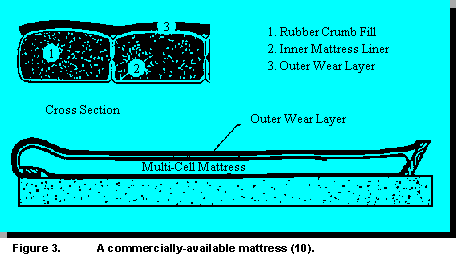 type of stall bed is gaining popularity especially in concrete
free-stalls. The mattresses are made of a tough interwoven material and sewn into longitudinal
segments. The segments are filled with an inert rubber material such as ground rubber (Figure
3).
The individual mattresses, one per stall, are covered with one continuous top sheet. The cost to
install these mattresses including labour is approximately $90 to $100 per stall. The material is
very resilient and appears to distribute the load, especially from bony protrusions, uniformly into
the mattress. Rodenberg et al. (8) reported that where these mattresses were available no cows
(0%) used the alleyways for resting and fewer hock injuries occurred (9.2%) compared to 1.1%
(alley cats) and 29% (hock injuries) for rubber mats, respectively.
type of stall bed is gaining popularity especially in concrete
free-stalls. The mattresses are made of a tough interwoven material and sewn into longitudinal
segments. The segments are filled with an inert rubber material such as ground rubber (Figure
3).
The individual mattresses, one per stall, are covered with one continuous top sheet. The cost to
install these mattresses including labour is approximately $90 to $100 per stall. The material is
very resilient and appears to distribute the load, especially from bony protrusions, uniformly into
the mattress. Rodenberg et al. (8) reported that where these mattresses were available no cows
(0%) used the alleyways for resting and fewer hock injuries occurred (9.2%) compared to 1.1%
(alley cats) and 29% (hock injuries) for rubber mats, respectively.
Usually a thin layer of dry bedding is spread over the fabric on a weekly basis to absorb moisture and reduce soiling (6). Bedding can consist of long straw, chopped straw, or kiln dried sawdust or shavings.
Earth freestall bed. An earth bed provides some cushion for cows resting in stalls and provides good footing during access to the stall (6). An earthen free-stall requires a significant amount of bedding for cow comfort. A disadvantage of this system is the maintenance of the bed level. Mechanical freestall levellers are not readily available.
Sand Bed. Clean sand provides an excellent bed for free-stalls as it moves readily because it is cohesionless. Growth of bacteria causing environmental mastitis is minimal as well. Sand that does work into the alley provides good traction for the cattle. The major disadvantage with sand usage is that the manure removal and handling systems must accommodate sand. Sand settles to the bottom of liquid manure storage and is abrasive to manure removal equipment. Quality of sand is very important as a high clay content will create mud when it comes in contact with moisture.
Cow Comfort and Floor Design
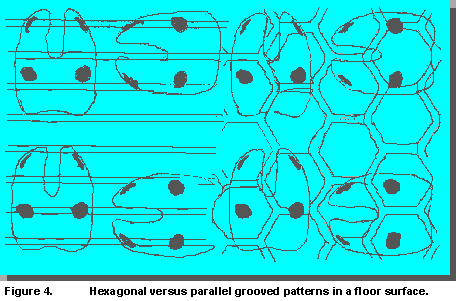 Skid-resistant walking surfaces reduce
injuries, and enhance estrus detection (1). Grooved floors are superior to smooth surfaces.
Figure
4 shows how a hexagonal pattern of grooves improve skid resistance over a parallel pattern of
grooves (7). Cows have been reported to walk from 180 to 2500 m per day in confined housing,
thus they are at a great risk of injury from smooth floors (15).
Skid-resistant walking surfaces reduce
injuries, and enhance estrus detection (1). Grooved floors are superior to smooth surfaces.
Figure
4 shows how a hexagonal pattern of grooves improve skid resistance over a parallel pattern of
grooves (7). Cows have been reported to walk from 180 to 2500 m per day in confined housing,
thus they are at a great risk of injury from smooth floors (15). The manure removal and collection system is related to cow comfort in that frequent removal results in better floor condition. Slotted or scraped alleyways can provide good floor condition for the cows. Infrequent floor cleaning leads to wet surfaces which in turn cause hooves to become softer and more foot related problems to develop. Also, wet concrete can be very abrasive to the hoof. Poor floor design results in animals being reluctant to walk from their resting area to the feed bunk. High stocking density or slippery flooring will discourage animal movement, especially by cows that are low in the social order dominance. Animals must not be forced to compete for restricted amounts of feed or limited bunk space (14).
Cow Comfort and Ventilation

During the winter, air exchange is provided as a result of warm air rising through the ridge vents and entering through side wall openings (Figure 5) . During the summer, the wind force exchanges the air by means of side panel openings on the windward and leeward side of the building. Munroe and colleagues (3) suggested that the thermostats for side curtain control be located 3m from the outside walls to maintain acceptable temperature distribution throughout the building. Chimneys are now recommended rather than continuous ridge vents. They are cheaper to build, make the building more bird proof, and protect the metal truss connections from the ammonia and water vapor produced in the animal airspace. Vertical moving insulated panels are superior to rotating inlet panels for introducing air. Air mixing may be limited in wide buildings as the incoming air has insufficient energy to encourage good mixing of the fresh and the resident air. Variable speed ceiling mounted fans are very effective in mixing the animals' airspace. During the winter, low air speeds should be maintained to minimize serious drafts; whereas during the summer high air speeds will facilitate cooling of the animals.
Exhaust fans and planned air inlets are used to provide air exchange in mechanically ventilated systems. In the Canadian Prairie climate, ventilation fans must provide a range of air flow rates (factor of 20) for winter and summer ventilation. Winter ventilation must be adequate to maintain acceptable air quality and reduce relative humidity. If ventilation rates are adjusted to maintain temperature during cold weather conditions, humidity and respirable dust level may rise to unacceptable levels. This will lead to building deterioration and exposure of cows to high levels of aerial contaminants. A minimum of 10 and 15 L/s/cow must be maintained at all times for a warm barn and a cold barn, respectively. Exhaust fans are normally evenly spaced on the leeward side of the building.
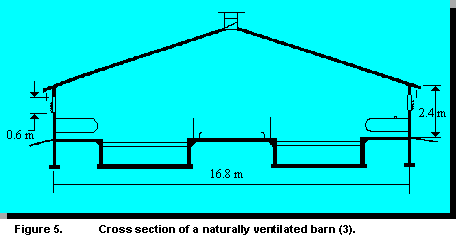 Air inlet design is very important in
maintaining a good distribution of fresh air into the animal airspace. During cold weather
conditions, many dairy barns still use open doors, holes in walls, and manure access ports as
fresh
air inlets. These openings result in drafts that can stress the cows or result in non-usable space
due to drafty areas. If drafts are occurring in your barn, you should contact an agricultural
engineer
to recommend changes to your existing barn. Poor air inlet design means that inlet openings are
too small in some areas, or too large in other areas. This results in areas being stagnant as a
result
of introducing an inadequate amount of fresh air and results in areas being drafty due to
excessive air being introduced. These two extreme conditions can occur even though the
overall ventilation rate is as recommended. Forced air recirculation is recommended for
mechanically ventilated barns since the fresh air entering through the planned inlets
usually does not have sufficient velocity to encourage good air mixing. Because of the low
ventilation requirement during winter conditions, most inlet openings cannot be made
small enough to achieve appropriate air speeds. Again ceiling mounted fans or
perforated recirculation ventilation tubes or ducts are effective in distributing fresh air
throughout the barn. A properly designed ventilation and heating system will result in
acceptable air quality and temperatures. This will reduce the exposure level of aerial
contaminants to the cow and provide the cow with an acceptable rate of heat exchange
between her body and the environment. Producers should be encouraged to buy
complete ventilation systems rather than buying components and trying to design systems
on their own (2). Technology should be adopted that has been proven to work in our
climate. Barns that are designed well for ventilation, facility, and floor functionality are a
pleasure to work in. A dreary, drafty, and smelly (high ammonia, relative humidity, and
temperature combination) barn is only entered when deemed necessary. This is reflected
in poor animal husbandry.
Air inlet design is very important in
maintaining a good distribution of fresh air into the animal airspace. During cold weather
conditions, many dairy barns still use open doors, holes in walls, and manure access ports as
fresh
air inlets. These openings result in drafts that can stress the cows or result in non-usable space
due to drafty areas. If drafts are occurring in your barn, you should contact an agricultural
engineer
to recommend changes to your existing barn. Poor air inlet design means that inlet openings are
too small in some areas, or too large in other areas. This results in areas being stagnant as a
result
of introducing an inadequate amount of fresh air and results in areas being drafty due to
excessive air being introduced. These two extreme conditions can occur even though the
overall ventilation rate is as recommended. Forced air recirculation is recommended for
mechanically ventilated barns since the fresh air entering through the planned inlets
usually does not have sufficient velocity to encourage good air mixing. Because of the low
ventilation requirement during winter conditions, most inlet openings cannot be made
small enough to achieve appropriate air speeds. Again ceiling mounted fans or
perforated recirculation ventilation tubes or ducts are effective in distributing fresh air
throughout the barn. A properly designed ventilation and heating system will result in
acceptable air quality and temperatures. This will reduce the exposure level of aerial
contaminants to the cow and provide the cow with an acceptable rate of heat exchange
between her body and the environment. Producers should be encouraged to buy
complete ventilation systems rather than buying components and trying to design systems
on their own (2). Technology should be adopted that has been proven to work in our
climate. Barns that are designed well for ventilation, facility, and floor functionality are a
pleasure to work in. A dreary, drafty, and smelly (high ammonia, relative humidity, and
temperature combination) barn is only entered when deemed necessary. This is reflected
in poor animal husbandry.
Lighting requirements must not be overlooked. Suggested lighting intensity for housing is 10 to 30 foot candles. Light meters to evaluate your barn are available from your Regional Agricultural Engineer. Sixteen to eighteen hours of light is considered optimal as this photoperiod has been observed to increase feed intake and milk yield by 6 to 16% (9).
Understanding Cow Energetics to Improve Cow Comfort
Drafts must be minimized during winter to reduce the thermal demand of the surrounding environment on the cow. However, during summer increased air speed in the immediate vicinity of the cow can result in significant heat loss due to convection. Heat transfer due to convection can increase by a factor of eight from still air to moving air (10 km/h). Free standing large diameter fans are very effective in increasing the heat dissipation rates from cows during warm weather conditions.
Dairy barns should be designed so that the dairy cows can select an environment to match their level of energetics or heat production. Due to a large variation in milk production and feed intake, cows have different levels of heat stress during periods of warm weather. If there is no opportunity to seek a cooler environment, high producing cows will reduce their feed intake since they are unable to dissipate this energy to their surrounding environment. Free standing fans provide an opportunity for heat-stressed cows to dissipate their sensible heat. Perhaps high air speeds are necessary near the feed bunk during warm weather as dairy cows prefer to eat in cool areas (4). The mean daily temperature where heat stress becomes apparent is between 24 and 270C, depending on level of feed intake and milk production. The most practical way to evaluate heat stress is to monitor respiration rate. Greater than 40 breathing cycles per minute indicates heat stress.
The cow's thermal environment is also affected by the group dynamics. Large groups congregating around fountains, feed bunks, or improperly designed alleyways again lessen the opportunity for proper heat exchange between the animal and its environment. The air speed between the animals becomes negligible and animals may become heat stressed due to poor heat exchange even if the temperature in 90% of the barn is adequate. Therefore, barn design must take into account the cow movement between the sleeping area, feed bunk, and the waterers (4).
During warm weather, dairy cows are often allowed access to an outdoor exercise yard. The solar heat load on dairy cows is often underestimated at this time. During the hot summer months, the solar load can approach 750W/m2 of surface area. This represents a significant portion of the 1200W produced by the animal. Natural shade or permanent shade structures should provide adequate space so that the animals don't crowd together. Feed and water must be close to the shade or cows will not leave the shade to eat or drink (5). If feed consumption drops when cows have access to an exercise yard, their time outside may have to be limited.
Cow Comfort and Straw- Bedded Housing
![]() Deep Straw Bedded Housing
Deep Straw Bedded Housing
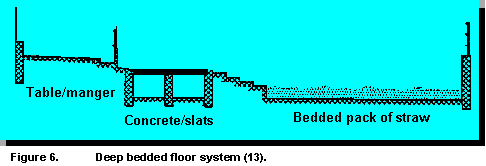 Deep straw bedded housing is the most
common bedded system (Figure 6). Straw usage in these systems ranges between 8 and 13
kg/cow/day. Danish researchers (13) reported that animals housed on a deep bedded pack did
not
show improved hygiene, udder health, feed disorders, and milk yield when compared to animals
housed in tie and free-stall barns. A total of 36 herds were used in this study. However,
observations in Alberta would indicate cow comfort and hygiene are excellent when ample
quantities of straw are used in loose housing systems. Comfort of the cow appears to be ideal.
Deep straw bedded housing is the most
common bedded system (Figure 6). Straw usage in these systems ranges between 8 and 13
kg/cow/day. Danish researchers (13) reported that animals housed on a deep bedded pack did
not
show improved hygiene, udder health, feed disorders, and milk yield when compared to animals
housed in tie and free-stall barns. A total of 36 herds were used in this study. However,
observations in Alberta would indicate cow comfort and hygiene are excellent when ample
quantities of straw are used in loose housing systems. Comfort of the cow appears to be ideal.
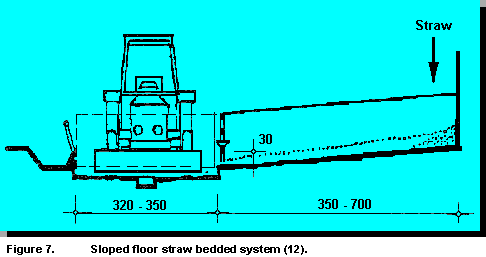 Sloped floors in straw-bedded
systems at seven to nine percent have performed well in moving the straw from the pen to a
scraper alley (Figure 7). This system uses about 2.5 kg of straw per day per head and the space
allocation per animal is about 7 m2. Danish research reported by Hansen (12) found that the
demand for straw bedding was less (33%) than when a deep bedding system was used. The
Danish researchers used a 5% slope floor and did not remove the straw bed for 2.5 years. In
either
system, feedstuffs with a high moisture content required up to twice as much bedding per day.
Salt levels in the diet should also be monitored as excessive salt intake will cause
increased water intake and subsequent urination.
Sloped floors in straw-bedded
systems at seven to nine percent have performed well in moving the straw from the pen to a
scraper alley (Figure 7). This system uses about 2.5 kg of straw per day per head and the space
allocation per animal is about 7 m2. Danish research reported by Hansen (12) found that the
demand for straw bedding was less (33%) than when a deep bedding system was used. The
Danish researchers used a 5% slope floor and did not remove the straw bed for 2.5 years. In
either
system, feedstuffs with a high moisture content required up to twice as much bedding per day.
Salt levels in the diet should also be monitored as excessive salt intake will cause
increased water intake and subsequent urination.
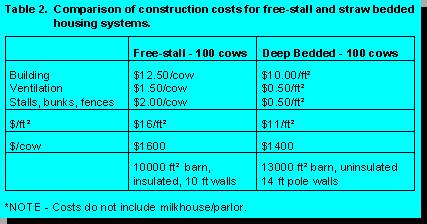 Relative construction costs between a
free-stall and a straw-bedded loose housing barn were estimated on the basis of a 100 milking
cow herd (Table 2). The 100 cows in the free-stall and the straw bedded system require 10,000
and 13,000 ft2 (1ft2=0.093 m2), respectively. The cost $/ft2 for each system is 16 and $11/ft2,
respectively. Therefore the cost per cow is $1600 and $1400/cow, respectively (Table 2). It is
interesting to note that there is a larger variation in costs between free-stall systems than
between
the free-stall and the straw bedded systems.
Relative construction costs between a
free-stall and a straw-bedded loose housing barn were estimated on the basis of a 100 milking
cow herd (Table 2). The 100 cows in the free-stall and the straw bedded system require 10,000
and 13,000 ft2 (1ft2=0.093 m2), respectively. The cost $/ft2 for each system is 16 and $11/ft2,
respectively. Therefore the cost per cow is $1600 and $1400/cow, respectively (Table 2). It is
interesting to note that there is a larger variation in costs between free-stall systems than
between
the free-stall and the straw bedded systems.
Summary
References